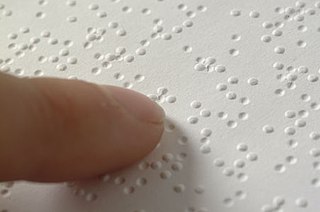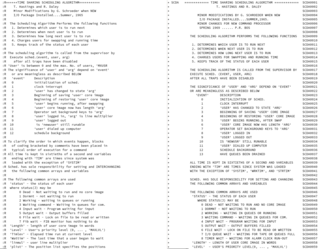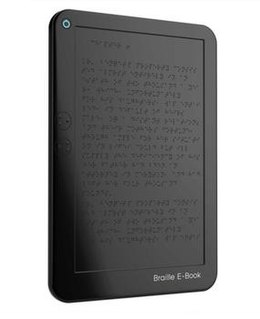
Assistive technology (AT) is a term for assistive, adaptive, and rehabilitative devices for people with disabilities and the elderly. Disabled people often have difficulty performing activities of daily living (ADLs) independently, or even with assistance. ADLs are self-care activities that include toileting, mobility (ambulation), eating, bathing, dressing, grooming, and personal device care. Assistive technology can ameliorate the effects of disabilities that limit the ability to perform ADLs. Assistive technology promotes greater independence by enabling people to perform tasks they were formerly unable to accomplish, or had great difficulty accomplishing, by providing enhancements to, or changing methods of interacting with, the technology needed to accomplish such tasks. For example, wheelchairs provide independent mobility for those who cannot walk, while assistive eating devices can enable people who cannot feed themselves to do so. Due to assistive technology, disabled people have an opportunity of a more positive and easygoing lifestyle, with an increase in "social participation," "security and control," and a greater chance to "reduce institutional costs without significantly increasing household expenses." In schools, assistive technology can be critical in allowing students with disabilities access the general education curriculum. Students who experience challenges writing or keyboarding, for example, can use voice recognition software instead.

Braille is a tactile writing system used by people who are visually impaired, including people who are blind, deafblind or who have low vision. It can be read either on embossed paper or by using refreshable braille displays that connect to computers and smartphone devices. Braille can be written using a slate and stylus, a braille writer, an electronic braille notetaker or with the use of a computer connected to a braille embosser.

A refreshable braille display or braille terminal is an electro-mechanical device for displaying braille characters, usually by means of round-tipped pins raised through holes in a flat surface. Visually impaired computer users who cannot use a standard computer monitor can use it to read text output. Deafblind computer users may also use refreshable braille displays.

An invention is a unique or novel device, method, composition or process. The invention process is a process within an overall engineering and product development process. It may be an improvement upon a machine or product or a new process for creating an object or a result. An invention that achieves a completely unique function or result may be a radical breakthrough. Such works are novel and not obvious to others skilled in the same field. An inventor may be taking a big step toward success or failure.

Louis Braille was a French educator and inventor of a reading and writing system for use by people who are visually impaired. His system remains virtually unchanged to this day, and is known worldwide simply as braille.

The Compatible Time-Sharing System (CTSS) was the first general purpose time-sharing operating system. Compatible Time Sharing referred to time sharing which was compatible with batch processing; it could offer both time sharing and batch processing concurrently.

The Perkins Brailler is a "braille typewriter" with a key corresponding to each of the six dots of the braille code, a space key, a backspace key, and a line space key. Like a manual typewriter, it has two side knobs to advance paper through the machine and a carriage return lever above the keys. The rollers that hold and advance the paper have grooves designed to avoid crushing the raised dots the brailler creates.
The Optacon is an electromechanical device that enables blind people to read printed material that has not been transcribed into Braille. The device consists of two parts: a scanner which the user runs over the material to be read, and a finger pad which translates the words into vibrations felt on the finger tips. The Optacon was conceived by John Linvill, a professor of Electrical Engineering at Stanford University, and developed with researchers at Stanford Research Institute. Telesensory Systems manufactured the device from 1971 until it was discontinued in 1996. Although effective once mastered, it was expensive and took many hours of training to reach competency. In 2005, TSI suddenly shut down. Employees were "walked out" of the building and lost accrued vacation time, medical insurance, and all benefits. Customers could not buy new machines or get existing machines fixed. Some work was done by other companies but no device with the versatility of the Optacon had been developed as of 2007. Many blind people continue to use their Optacons to this day. The Optacon offers capabilities that no other device offers including the ability to see a printed page or computer screen as it truly appears including drawings, typefaces, and specialized text layouts.
Tactile graphics, including tactile pictures, tactile diagrams, tactile maps, and tactile graphs, are images that use raised surfaces so that a visually impaired person can feel them. They are used to convey non-textual information such as maps, paintings, graphs and diagrams.
A braille translator is a software program that translates a script into braille and sends it to a braille embosser, which produces a hard copy of the original print text. Only the script is transformed, not the language.

A timeline of United States inventions encompasses the ingenuity and innovative advancements of the United States within a historical context, dating from the Contemporary era to the present day, which have been achieved by inventors who are either native-born or naturalized citizens of the United States. Patent protection secures a person's right to his or her first-to-invent claim of the original invention in question, highlighted in Article I, Section 8, Clause 8 of the United States Constitution which gives the following enumerated power to the United States Congress:
To promote the Progress of Science and useful Arts, by securing for limited Times to Authors and Inventors the exclusive Right to their respective Writings and Discoveries.
The Lemelson Foundation is an American 501(c)(3) private foundation. It was started in 1993 by Jerome H. Lemelson and his wife Dorothy.
Braille technology is assistive technology which allows blind or visually impaired people to do common tasks such as writing, browsing the Internet, typing in Braille and printing in text, engaging in chat, downloading files, music, using electronic mail, burning music, and reading documents. It also allows blind or visually impaired students to complete all assignments in school as the rest of sighted classmates and allows them take courses online. It enables professionals to do their jobs and teachers to lecture using hardware and software applications. The advances of Braille technology are meaningful because blind people can access more texts, books and libraries and it also facilitates the printing of Braille texts.

Accessible publishing is an approach to publishing and book design whereby books and other texts are made available in alternative formats designed to aid or replace the reading process. It is particularly relevant for people who are blind, visually impaired or otherwise print disabled.

A timeline of United States inventions (1946–1991) encompasses the ingenuity and innovative advancements of the United States within a historical context, dating from the era of the Cold War, which have been achieved by inventors who are either native-born or naturalized citizens of the United States. Copyright protection secures a person's right to his or her first-to-invent claim of the original invention in question, highlighted in Article I, Section 8, Clause 8 of the United States Constitution which gives the following enumerated power to the United States Congress:
To promote the Progress of Science and useful Arts, by securing for limited Times to Authors and Inventors the exclusive Right to their respective Writings and Discoveries.

Frank Haven Hall was an American inventor and essayist who is credited with inventing the Hall braille writer and the stereographer machine. He also invented the first successful mechanical point writer and developed major functions of modern day typography with kerning and tracking.

A braille e-book is a refreshable braille display using electroactive polymers or heated wax rather than mechanical pins to raise braille dots on a display. Though not inherently expensive, due to the small scale of production they have not been shown to be economical.

Ramesh Raskar is a Massachusetts Institute of Technology Associate Professor and head of the MIT Media Lab's Camera Culture research group. Previously he worked as a Senior Research Scientist at Mitsubishi Electric Research Laboratories (MERL) during 2002 to 2008. He holds 132 patents in computer vision, computational health, sensors and imaging. He received the $500K Lemelson–MIT Prize in 2016. The prize money will be used for launching REDX.io, a group platform for co-innovation in Artificial Intelligence. He is well known for inventing EyeNetra, EyeCatra and EyeSelfie, Femto-photography and his TED talk for cameras to see around corners.
JD Albert is an American engineer, inventor, and educator. Albert is one of the inventors of microencapsulated electrophoretic display commonly used in electronic devices such as e-readers.
The machine translation of sign languages has been possible, albeit in a limited fashion, since 1977. When a research project successfully matched English letters from a keyboard to ASL manual alphabet letters which were simulated on a robotic hand. These technologies translate signed languages into written or spoken language, and written or spoken language to sign language, without the use of a human interpreter. Sign languages possess different phonological features than spoken languages, which has created obstacles for developers. Developers use computer vision and machine learning to recognize specific phonological parameters and epentheses unique to sign languages, and speech recognition and natural language processing allow interactive communication between hearing and deaf people.














